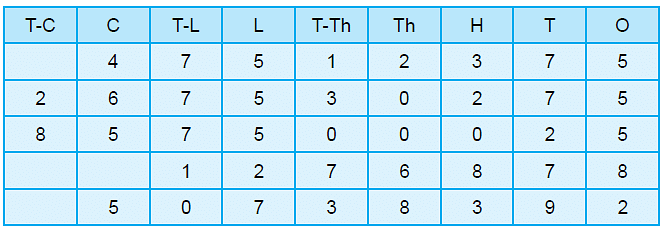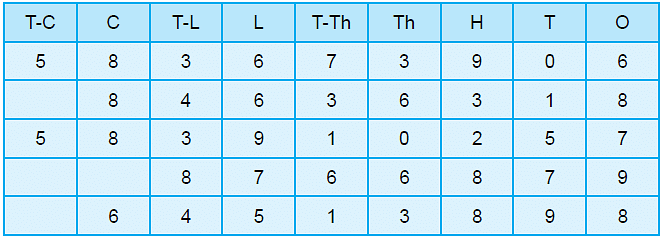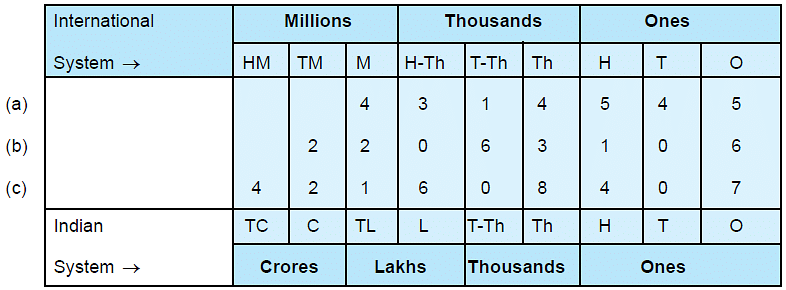Class 5 Maths Practice Question Answers - Large Numbers
Question 1: Write each of the following numbers in figures:
(a) Forty-five lakh, three thousand, six.
(b) Five crore, twenty-one lakh, five thousand, seven hundred forty-seven.
(c) Twenty-one crore, seventeen lakh, eighty-one thousand, two hundred sixteen.
(d) Eighty-four crore, thirty-six thousand, nine hundred six.
(a) Forty-five lakh, three thousand, six.
(b) Five crore, twenty-one lakh, five thousand, seven hundred forty-seven.
(c) Twenty-one crore, seventeen lakh, eighty-one thousand, two hundred sixteen.
(d) Eighty-four crore, thirty-six thousand, nine hundred six.
Question 2: Arrange the following numbers in ascending order :
4,75,12,375; 26,75,30,275; 85,75,00,025; 12,76,878; 5,07,38,392
First we arrange the given numbers in the place-value chart:
Out of the given numbers, two are 9-digit numbers, two are 8-digit numbers and one is a 7-digit number.
In 9-digit numbers, clearly 26,75,30,275 < 85,75,00,025
In 8-digit numbers, clearly 4,75,12,375 < 5,07,38,392
Clearly, the 7-digit number is the smallest.
So, 12,76,878 < 4,75,12,375 < 5,07,38,392 < 26,75,30,275 < 85,75,00,025
Hence, the given numbers in ascending order are:
12,76,878; 4,75,12,375; 5,07,38,392; 26,75,30,275; 85,75,00,025
Question 3: Write the following numbers in words :
(a) 23,58,954
(b) 5,03,94,681
(c) 8,59,24,639
(d) 54,38,74,094
Starting from the right, we make entries of the digits of each number in the
place-value chart:
Question 4: Find the difference of the place-values of the two 7s in 53,69,70,174.
Place value of 1st 7 from right (i.e., 7 at the tens place) = 7 × 10 = 70
Place value of 2nd 7 from right (i.e., 7 at the ten thousands place) = 7 × 10,000 = 70,000
Hence, difference of the place-values = 70,000 – 70 = 69,930.
Question 5: Compare :
(a) 3,52,90,634 and 3,47,20,956
(b) 7,30,98,468 and 7,30,58,390
(a) Consider 3,52,90,634 and 3,47,20,956. Both are 8-digit numbers. We start from
the left-most digits.
Here, 3 = 3.
Next, we compare the second digits from the left.
Here, 5 > 4.
Thus, 3,52,90,634 > 3,47,20,956.
(b) Consider 7,30,98,468 and 7,30,58,390. Both are 8-digit numbers.
7 = 7 (left-most digits)
3 = 3 (second digits from the left)
0 = 0 (third digits from the left)
9 > 5 (fourth digits from the left)
Thus, 7,30,98,468 > 7,30,58,390
Question 6: Write each of the following numbers in figures :
(a) Three hundred seven thousand, eight hundred twenty-one.
(b) Two million, seven hundred thirty-four thousand, one hundred twelve.
(c) Forty-five million, seven hundred ten thousand, twenty-nine.
(d) Nine hundred forty-six million, two thousand, four hundred twenty-five.
We can show the given numbers in the International place-value chart as follows:
Hence, the required numbers in figures are :
(a) 307,821
(b) 2,734,112
(c) 45,710,029
(d) 946,002,425
Question 7: Write the number five crore, six lakh, ten thousand, nine hundred twenty-nine in figures.
We proceed as follows:
Step I: Make four periods as shown.
The first period from right will have three parts, second, third and fourth periods will have two parts each
Step II: Write all the crores in the first period from the left.
We fill all the parts, for example, if it is 5 crore, we write 05.Step III: Write all the lakhs in the second period from the left. Again we fill all the parts, for example, if it is 6 lakh, we write 06.
Step IV: Write all the thousands in the third period from the left.
Step V: Write the hundreds, tens and ones in the fourth period from the left.
Now, if the number begins with 0 on the extreme left, drop the zero.
Thus, five crore, six lakh, ten thousand, nine hundred twenty-nine is written as 5,06,10,929.
Question 8: Arrange the following numbers in descending order :
58,36,73,906; 8,46,36,318; 58,39,10,257; 87,66,879; 6,45,13,898
First we arrange the given numbers in the place value chart
Out of the given numbers, two are 9-digit numbers, two are 8-digit numbers and one is
a 7-digit number.
In 9-digit numbers, clearly 58,39,10,257 > 58,36,73,906.
In 8-digit numbers, clearly 8,46,36,318 > 6,45,13,898.
Clearly, the 7-digit number is the smallest.
So, 58,39,10,257 > 58,36,73,906 > 8,46,36,318 > 6,45,13,898 >87,66,879.
Hence, the given numbers arranged in descending order are:
58,39,10,257; 58,36,73,906; 8,46,36,318; 6,45,13,898; 87,66,879.
Question 9: Round off to the nearest ten :
(a) 73
(b) 145
(c) 295
(d) 3,244
(e) 51,766
(a) 73 when rounded off to the nearest 10 becomes 70.
(b) 145 becomes 150.
(c) 295 becomes 300. (Here, 9+1 =10, so 2 in the hundreds place becomes3)
(d) 3,244 becomes 3,240.
(e) 51,766 becomes 51,770.
From the above examples, we can say that, in order to round off a number to the nearest ten :
(a) We replace the digit in the ones place by 0.
(b) When the replaced digit is 5, 6, 7, 8 or 9, we increase the digit in the tens place by 1, otherwise we make no other change.
Question 10: Write the greatest and the smallest 7-digit numbers (without repeating a digit) from the following digits :
(a) 4, 7, 6, 3, 1, 2 and 9
(b) 2, 5, 6, 4, 0, 3 and 7
(a) Arrange the given digits i.e., 4, 7, 6, 3, 1, 2 and 9 in descending order, we get 9764321. Thus, the greatest number is 97,64,321.
Similarly, by arranging the given digits in ascending order, we get the smallest number. Thus, the smallest number is 12,34,679.
(b) Similarly, greatest number is 76,54,320 and smallest number is 20,34,567
Question 11: Rewrite the following numbers using International place-value system.
(a) Fifteen lakh, four thousand, twelve.
(b) Eight crore, ten lakh, six hundred twenty-nine.
(c) Thirty-six crore, five lakh, eleven thousand, two hundred forty.
Arrange the given numbers in Indian place value-chart.
Now, we can express the given numbers using the International place-value chart.
(a) One million, five hundred four thousand, twelve.
(b) Eighty-one million, six hundred twenty-nine.
(c) Three hundred sixty million, five hundred eleven thousand, two hundred forty.
Question 12: Find the successor of the :
(a) greatest 7-digit number
(b) smallest 6-digit number
(a) Greatest 7-digit number is 99,99,999.
Thus, successor of 99,99,999 is 99,99,999 + 1 = 1,00,00,000.
(b) Smallest 6-digit number is 1,00,000.
Thus, successor of 1,00,000 is 1,00,000 + 1 = 1,00,001.
Question 13: Round off to the nearest hundred :
(a) 263 (b) 1,350 (c) 4,731 (d) 5,660 (e) 32,892 (f) 53,960
(a) 263 becomes 300.
(b) 1,350 becomes 1,400.
(c) 4,731 becomes 4,700.
(d) 5,660 becomes 5,700.
(e) 32,892 becomes 32,900.
(f) 53,960 becomes 54,000 because 960 becomes 1,000 and 53,000 + 1,000 = 54,000.
From the above, we can say that in order to round off a number to the nearest hundred:
(a) We replace the tens and ones digits by 00.
(b) If the tens digit is 5 or greater than 5, we increase the digit in the hundreds place by 1, otherwise we make no other change.
Question 14: Write the place-value of 7 in each of the following numbers :
(a) 2,73,49,008
(b) 75,92,54,164
(c) 30,05,97,214
Let us arrange the digits of the numbers in the place-value chart.
(a) Place-value of 7 in 2,73,49,008 = 7 × 10,00,000 = 70,00,000
(b) Place-value of 7 in 75,92,54,164 = 7 × 10,00,00,000 = 70,00,00,000
(c) Place-value of 7 in 30,05,97,214 = 7 × 1,000 = 7,000.
Question 15: Rewrite the following numbers using Indian place-value system.
(a) Four million, three hundred fourteen thousand, five hundred forty-five.
(b) Twenty-two million, sixty-three thousand, one hundred six.
(c) Four hundred twenty-one million, six hundred eight thousand, four hundred seven.
Arrange the given numbers in the International place-value chart.
Now, we can express the given numbers using Indian place-value chart.
(a) Forty three lakh, fourteen thousand, five hundred forty-five.
(b) Two crore, twenty lakh, sixty-three thousand, one hundred six.
(c) Forty-two crore, sixteen lakh, eight thousand, four hundred seven.
Question 16: Write 54,73,92,510 in the expanded form.
Thus, 54,73,92,510 = 50,00,00,000 + 4,00,00,000 + 70,00,000 + 3,00,000 + 90,000 + 2,000 + 500 + 10 + 0
Question 17: Find the predecessor of the:
(a) Smallest 9-digit number.
(b) Greatest 7-digit number.
(a) Smallest 9-digit number is 10,00,00,000.
Thus, predecessor of 10,00,00,000 is 10,00,00,000 – 1 = 9,99,99,999.
(b) Greatest 7-digit number is 99,99,999.
Thus, predecessor of 99,99,999 is 99,99,999 – 1 = 99,99,998.
Question 18: Round off to the nearest thousand:
(a) 971 (b) 3,501 (c) 8,489 (d) 29,604 (e) 5,99,512
(a) 971 becomes 1,000.
(b) 3,501 becomes 4,000.
(c) 8,489 becomes 8,000.
(d) 29,604 becomes 30,000 because 29 + 1 = 30.
(e) 5,99,512 becomes 6,00,000 because 599 + 1 = 600.
From the above we can say that in order to round off a number to the nearest thousand:
(a) We replace the hundreds, tens and ones digits by 000.
(b) If the hundreds digits is 5 or greater than 5, we increase the digit in the thousands place by 1, otherwise we make no other change.
Rounding off to the nearest ten thousand or lakh or even greater place can be done following the similar line of action.
Question 19: Write the greatest and the smallest 8-digit numbers using all the following digits (you may repeat the digits) :
7, 2, 0, 1, 8, 3, 4
The greatest number is 8,87,43,210.
The smallest number is 1,00,23,478.
Question 20: Using the International place-value system, write the number names for each of the following numbers:
(a) 251,964 (b) 1,085,739 (c) 18,923,584 (d) 309,754,318
Let us arrange the digits in the International place-value chart.
(a) Two hundred fifty-one thousand, nine hundred sixty-four.
(b) One million, eighty-five thousand, seven hundred thirty-nine.
(c) Eighteen million, nine hundred twenty-three thousand, five hundred eighty-four.
(d) Three hundred nine million, seven hundred fifty-four thousand, three hundred eighteen.
Question 21: Which is greater?
(a) 5,73,89,204 or 75,29,301
(b) 9,20,01,473 or 54,21,73,480
(a) 5,73,89,204 has 8 digits and 75,29,301 has 7 digits.
Thus, 5,73,89,204 > 75,29,301 or 75,29,301 < 5,73,89,204.
(b) 9,20,01,473 has 8 digits and 54,21,73,480 has 9 digits.
Thus, 54,21,73,480 > 9,20,01,473 or 9,20,01,473 < 54,21,73,480.
Question 22: A 3-digit number was rounded off to the nearest hundred and the result was 600. Find the interval of the original number.
Each of the numbers from 550 to 599 can be rounded off as 600.
Also, each of the numbers from 601 to 649 can be rounded off as 600.
Thus, interval of the original number is 550 to 649.
|
58 videos|122 docs|40 tests
|
FAQs on Class 5 Maths Practice Question Answers - Large Numbers
| 1. What is the concept of a large number in mathematics? |  |
| 2. How can large numbers be represented in numerical form? |  |
| 3. What are some techniques to perform calculations with large numbers? |  |
| 4. How can large numbers be compared or ordered? |  |
| 5. What are some real-life examples where large numbers are used? |  |

|
Explore Courses for Class 5 exam
|

|





































